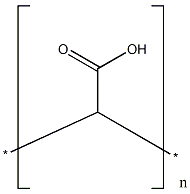Carbomer
- CAS NO.:9007-20-9
- Empirical Formula: C15H17ClO3
- Molecular Weight: 280.74668
- MDL number: MFCD00084394
- EINECS: 618-435-5
- SAFETY DATA SHEET (SDS)
- Update Date: 2025-12-17 09:50:42

What is Carbomer?
Description
Poly(acrylic acid) (PAA; trade name Carbomer) is a polymer with the formula (CH2-CHCO2H)n. It is a derivative of acrylic acid (CH2=CHCO2H). In addition to the homopolymers, a variety of copolymers and crosslinked polymers, and partially deprotonated derivatives thereof are known and of commercial value. In a water solution at neutral pH, PAA is an anionic polymer, i.e., many of the side chains of PAA lose their protons and acquire a negative charge. Partially or wholly deprotonaated PAAs are polyelectrolytes, with the ability to absorb and retain water and swell to many times their original volume. These properties - acid-base and water-attracting - are the bases of many applications.
Chemical properties
"wets" very quickly
The Uses of Carbomer
Carbomers are acrylic acid polymers that are used for a variety of purposes. They are used in pharmaceutical processes as suspending agents, gel bases, emulsifiers, and binding agents. They are also used as artificial tears. Carbomer 974P is a carbomer that is the major non-aqueous component (5% polymer, 94% water) of a proprietary formulation called BufferGel, which also contains dibasic potassium phosphate, magnesium sulfate, dibasic sodium phosphate, sorbic acid, monobasic sodium phosphate, and disodium EDTA. It is a buffering agent, a microbicide, and a spermicide. It is formulated in an aqueous gel at pH 3.9, which acidifies twice its volume of semen to a pH of 5 and maintains the protective acidity of the vagina. It is used vaginally as a spermicide that also protects against HIV infection and possibly other sexually transmitted diseases.
The Uses of Carbomer
Carbomer is widely used in cosmetic uses e.g., clear gels, hydro-alcoholic gels, lotions and creams.
The Uses of Carbomer
Poly(Acrylic Acid) is a thickening, suspending, dispersing, emulsifying agent. In the cosmetic and textile printing fields, in printing inks, in emulsion-based lubricants, in pharmaceuticals, polishes, waxes, paints, waterproof and oil-proof coatings, in industrial specialties.
Carbomer applications
Carbomer is a thickening agent that help control the viscosity and flow of cosmetic products. They also help distribute and suspend insoluble solids into liquid, and prevent the oil and liquid parts of a solution from separating. They have the ability to absorb and retain water, and can swell up to 1000 times their original volume when dispersed in water. It is contained in a wide range of personal care products such as styling gel, facial moisturizer, sunscreen, shampoo, anti-aging treatment, eye cream, cleanser and scrubs.
brand name
Carbopol 934P (Noveon); Carbopol 974P (Noveon).
Preparation
Carbomer is a synthetic polymer of acrylic acid with high molecular weight that are crosslinked with either allyl sucrose or allyl ethers of pentaerythritol.
Side Effects
Carbomer's adverse reactions is irritation. Uncommon side effects (may affect up to 1 in 100 people): eye swelling, eye pain, itchy eye, eye redness, increased tear production.
Safety
The safety of carbomers has been assessed by the Cosmetic Ingredient Review Expert Panel, a group responsible for evaluating the safety of skincare and cosmetics. Carbomer polymers demonstrated a low potential for phototoxicity, photo-contact allergenicity, skin irritation and sensitization at concentrations up to 100%. Upon evaluation of the scientific data, the CIR Expert Panel concluded that carbomer polymers were safe as ingredients in cosmetics and personal care products.
Synthesis
Precipitation polymerization: Carbomers are synthesized by free radical precipitation polymerization conducted in organic solvents. The solvents for this process are selected such that the monomers, initiators and other additives are soluble in the reaction medium, but the resulting polymer product is not.
Properties of Carbomer
| Boiling point: | 116 °C |
| Density | 1.2 g/mL at 25 °C |
| refractive index | n |
| EPA Substance Registry System | Carbomer (9007-20-9) |
Safety information for Carbomer
Computed Descriptors for Carbomer
| SMILES | C(C(*)*)(=O)O |$;;*;*;;$| |
Carbomer manufacturer
Friedrich Organic Chemicals India Private Limited
New Products
4,4-Difluoropiperidine hydrochloride tert-butyl 9-methoxy-3-azaspiro[5.5]undecane-3-carboxylate Indole Methyl Resin N-Isopropylurea N,N-Dicyclohexylcarbodiimide(DCC) MELDRUMS ACID 5-METHYLISOXAZOLE-4-CARBOXYLIC ACID Magnessium Bis glycinate Zinc ascorbate 1-bromo-2-butyne 2-acetamidophenol 9(10H)-anthracenone Erythrosin B, 4-Piperidinopiperidine 2-((4-morpholinophenylamino) (methylthio) methylene) malononitrile 2,4-dihydroxybenzaldehyde 3-(4-morpholinophenylamino)-5-amino-1H-pyrazole-4-carbonitrile Methyl 2-methylquinoline-6-carboxylate 2,6-dichloro-4-nitropyridine 4-Bromo-2-chlorobenzonitrile 2-(benzylamino)acetic acid hydrochloride 4-(tert-Butoxycarbonylamino)but- 2-ynoic acid 3,4-dihydro-2H-benzo[b][1,4]dioxepine 1-Phenyl-1-cycloprppanecarboxylicacidRelated products of tetrahydrofuran








You may like
-
 Carbopol 940 Polymer, Purity: 99.99View Details
Carbopol 940 Polymer, Purity: 99.99View Details
9007-20-9 -
 3-(4-amino-1-oxoisoindolin-2-yl)-1-methylpiperidine-2,6-dione 98%View Details
3-(4-amino-1-oxoisoindolin-2-yl)-1-methylpiperidine-2,6-dione 98%View Details -
 614-19-7 98%View Details
614-19-7 98%View Details
614-19-7 -
 3112-85-4 Methyl phenyl sulfone 98%View Details
3112-85-4 Methyl phenyl sulfone 98%View Details
3112-85-4 -
 20677-73-0 (2,2-diethoxyethyl)methylamine 98%View Details
20677-73-0 (2,2-diethoxyethyl)methylamine 98%View Details
20677-73-0 -
 3-(4-(hydroxyamino)-1-oxoisoindolin-2-yl)piperidine-2,6-dione 98%View Details
3-(4-(hydroxyamino)-1-oxoisoindolin-2-yl)piperidine-2,6-dione 98%View Details -
 57381-49-4 2-bromo-4-chlorobenzonitrile 98%View Details
57381-49-4 2-bromo-4-chlorobenzonitrile 98%View Details
57381-49-4 -
 4,6-dichloropyrimidine-5-carbaldehyde 98%View Details
4,6-dichloropyrimidine-5-carbaldehyde 98%View Details
5305-40-8
